In silico-in vivo analysis tool for the modeling of initiation and growing of atheroma plaque
SUMMARY
The main goal of the presented project is to approach the study of atherogenesis at its early development from different perspectives, encompassing the development of multiphysics computer models, in vitro techniques to reproduce the mechanical conditions of atheroma plaque formation and an experimental animal study to, in a way, validate the obtained results. Cardiovascular diseases (CVD) are the leading cause of death and disability in developed countries. All efforts devoted to increase knowledge about the development and evolution of these diseases, their diagnosis and the improvement of treatments will imply a high impact on the society. Atherosclerosis or appearance and development of deposits of atheroma plaques in arteries is the major cause of CVD, leading to a reduction or complete blockage of blood flow and, in case of vulnerable plaques, could cause plaque rupture thus producing different ischemic syndromes such as heart attacks or strokes. Atherogenesis is a degenerative and chronic inflammatory process in which multiple factors are involved, being some of them plainly mechanical. Some of the factors or processes that play an important role in this pathology are endothelial lesions and/or permeability, hemodynamic factors such as WSS, LDL, LDL oxidation, proliferation and/or migration of different cell populations as monocytes, macrophages or muscle cells, concentration of growth factors, inflammatory adhesion molecules, components of the ECM, etc. It is very important to detect the appearance and evolution of atherosclerotic plaques, as well as those lesions prone to rupture. Due to the multifactorial nature of this disease, the study of the atherosclerosis disease pretend to be tackled from different perspectives, combining numerical computational simulations, advanced in vitro cell culture techniques on microfluidic devices and assessment of the pathology thanks to an experimental animal model.
 Concentration evolution and concentration contour map after 10 years of systemic high blood cholesterol level |  Phase-contrast images of a monolayer of HUVECs on the microfluidic device |
Also, together with other progress made in previous projects, these models will be applied to improve the current treatment of the disease, leading to a greater effectiveness in spreading drugs, both anti-inflammatory and anti-proliferative.

Spanish Ministry of Research and Innovation through the research project DPI2016-76630-C2-1-R
